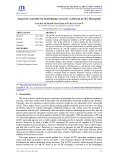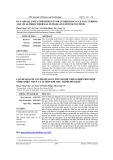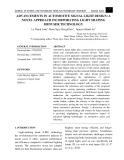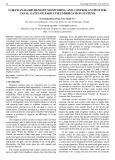
8 Nguyen Hoang Vinh, Doan Cong Chanh, Phan Hoang Nam, Hoang Phuong Hoa, Gianluca Quinci
AN OVERVIEW OF PERFORMANCE-BASED SEISMIC DESIGN
METHODOLOGY FOR BRIDGES
Nguyen Hoang Vinh1, Doan Cong Chanh1,2, Phan Hoang Nam1*, Hoang Phuong Hoa1, Gianluca Quinci3
1The University of Danang - University of Science and Technology, Da Nang, Vietnam
2School of Engineering, Tra Vinh University, Tra Vinh, Vietnam
3Roma Tre University, Rome, Italy
*Corresponding author: phnam@dut.udn.vn
(Received: September 06, 2024; Revised: October 09, 2024; Accepted: October 15, 2024)
DOI: 10.31130/ud-jst.2024.510E
Abstract - The Performance-Based Seismic Design (PBSD) is an
advanced approach to designing earthquake-resistant structures,
ensuring that a building meets specific performance objectives
under seismic impacts. Unlike traditional design codes, PBSD
aims to predict and control the damage to structures based on
defined earthquake levels, minimizing damage and repair costs
after an earthquake. The PBSD process includes defining
performance objectives, selecting appropriate analysis models,
conducting nonlinear analyses, and evaluating damage levels.
Analytical methods such as nonlinear static pushover analysis and
dynamic time history analysis are commonly applied in this
process. Due to the need for in-depth knowledge and complex
calculations, implementing PBSD can present significant
challenges. This paper aims to present the details of PBSD based
on seismic design codes and applies this approach to seismic
design for bridges under earthquakes.
Keywords - Performance-based design; performance objective;
push-over analysis; time history analysis; bridge.
1. Introduction
Significant historical seismic events, such as the
Northridge earthquake in the US in 1994, the Kobe
earthquake in Japan in 1995, the Chichi earthquake in
Taiwan in 1999, and the Tōhoku earthquake and tsunami
in Japan in 2011 have caused serious damage to bridges
on highways, disrupting traffic and causing great
economic and social losses [1-4]. Common damages
include cracks and complete collapse of load-bearing
structures such as columns, piers, bearings, etc. due to
uneven displacement between structural components or
the formation of plastic joints due to large deformation
during shock absorption [2, 3, 5, 6].
Field observation studies after these seismic events
have shown that the main cause of damage is that the old
seismic design standards have not fully and accurately
assessed the level of risk and impact of earthquakes on
structures [3]. The seismic design perspective in current
standards in many countries around the world still has
some limitations, in which the use of linear elastic analysis
methods for the entire structural system is difficult to
reliably reflect the responses and damage of the structure,
especially non-linear dynamic responses. Therefore, in
recent decades, many studies have focused on developing
and perfecting the seismic design process. One of the
advanced methods is performance-based seismic design
(PBSD) [7]. PBSD was initially applied to high-rise
buildings in high seismic areas. The method gained traction
in the 1990s, particularly after the 1994 Northridge
earthquake and the 1989 Loma Prieta earthquake in
California when traditional seismic design methods were
found to be inadequate. The method was later extended to
other types of structures, including bridges and other
critical infrastructures.
PBSD is an advanced approach to earthquake-resistant
structural design. It focuses on designing structures to meet
specific performance objectives under different earthquake
levels, rather than simply following traditional design
codes. PBSD allows engineers to predict and manage the
extent of damage to structures by considering factors such
as acceptable damage levels, downtime, and repair costs,
thereby optimizing design solutions to minimize damage
and costs.
Despite many advantages over traditional methods, the
application of PBSD in Vietnam is still very limited.
limited by the lack of specialized human resources,
technical standards, high design costs, lack of technology,
and analysis software, especially the low priority of
investment for large, complex projects because Vietnam is
located in an area of small and medium earthquakes. Some
studies have initially introduced PBSD. Specifically, in the
study of Nguyen Hong Ha et al. [8], this method was
briefly presented with instructions for application to high-
rise buildings and frames. Some other studies, although not
yet comprehensively implementing the method, have
focused on analyzing the static and nonlinear dynamic
behavior of structures under specific earthquake intensities
using deterministic [9-14]and probabilistic [15, 16].
Worldwide, PBSD has been developed and integrated
into design standards of countries such as the US, Japan,
New Zealand, China, and Europe for both high-rise
buildings and bridges [17-23]. Based on PBSE, a more
advanced method has also been developed, which is
Performance-Based Earthquake Engineering (PBEE) [24].
PBEE is a comprehensive earthquake-resistant structure
evaluation and design method, focusing on predicting and
controlling the specific responses of structures to
earthquakes based on probabilistic models. This method not
only focuses on bearing capacity but also considers other
factors such as economic loss, downtime, and human safety.
On that basis, the paper aims to provide an overview of
PBSD with an emphasis on the sequence and content of the
method based on a review of research literature and current

ISSN 1859-1531 - THE UNIVERSITY OF DANANG - JOURNAL OF SCIENCE AND TECHNOLOGY, VOL. 22, NO. 11B, 2024 9
seismic design standards in some developed countries.
Next, the paper presents guidelines for applying PBSD in
seismic design for earthquake-resistant bridges. Finally,
conclusions and recommendations for this design method
in Vietnam conditions are presented specifically.
2. General procedure
PBSD is a sophisticated seismic design approach, first
proposed and developed in the early 1990s. The concept
has attracted attention from the work of researchers in the
United States, especially from the Vision 2000 report
published by the Structural Engineers Association of
California (SEAOC) in 1995 [25]. This report laid the
foundation for PBSD by defining a design framework for
structures to meet specific performance objectives under
different seismic hazard levels.
PBSD aims to provide an accurate and reliable
assessment of the performance of a structure against
different seismic intensities over its lifetime, ensuring that
the structure meets the proposed performance
requirements. This method has been widely deployed
around the world, not only for calculating and upgrading
old structures but also for designing new structures. The
PBSD process begins with the establishment of specific
performance objectives. Next, the consultant will carry out
design and analysis steps to ensure that the structure can
achieve these objectives under seismic conditions at
different risk levels.
Figure 1. General procedure of PBSD
The general procedure of the method is shown in Figure
1 and specifically has the following main steps:
(1) Conceptual design and performance objective
definition.
The PBSD process begins with conceptual design and
the definition of specific performance objectives for the
structure under different seismic levels. These objectives
are usually agreed upon between the owner and the design
consultant based on the conceptual design, including the
safety and performance requirements of the structure. The
performance objectives are determined based on the
combination of the desired performance level of the
structure and the seismic hazard level. Depending on the
type of structures, scale, importance, and investment cost,
appropriate objectives need to be determined to ensure that
the desired safety and performance requirements are met.
(2) Preliminary design.
In PBSD, the preliminary design step is the foundation
for guiding the seismic requirements of the structure.
Based on the selected performance levels, seismic hazard
levels, and performance objectives, the preliminary
structure is established with elements such as beams,
columns, partitions, and other load-bearing members,
ensuring the load-bearing capacity is suitable for the
determined performance objectives.
(3) Model selection and seismic response analysis.
The selection of analytical models and methods for
earthquake-resistant bridges is an important part of the
design and assessment of the structure’s resistance to
earthquakes. Based on the performance objectives and the
seismic hazard levels, appropriate analytical models are
developed for the structure, for example:
- 2D, 3D models;
- Linear and nonlinear models;
- Rigid model, plastic model (distributed plastic model
and concentrated plastic model);
- The model considers and does not consider soil-
structure interactions.
From the selection of the model, the earthquake
analysis methods also need to be selected, for example:
- Equivalent horizontal static force analysis method;
- Nonlinear static analysis method of gradual push;
Time history dynamic analysis method.
Based on the selected model and analysis method,
seismic analyses are performed to determine the response
of the structure to different earthquake levels. Nonlinear
analyses are often used to determine Engineering Demand
Parameters (EDP) such as displacements, forces, and
deformations of structural elements.
(4) Evaluation of the performance of structural and
non-structural elements.
Results from earthquake analyses are used to evaluate
the performance of structures through the evaluation of the
performance of structural and non-structural elements.
This process includes:
- Determine potential damage levels based on analysis
results.
- Compare the seismic responses with the performance
criteria.
(5) Compare and adjust designs.
At each step of design and analysis. The achievement
of performance objectives should be evaluated. If the
project does not achieve the stated performance objectives,
design adjustments should be made.
(6) Repeat the analysis and evaluation process and
finalize the design and report.
PBSD is an iterative process where the design can be
adjusted and re-analyzed repeatedly until the structure

10 Nguyen Hoang Vinh, Doan Cong Chanh, Phan Hoang Nam, Hoang Phuong Hoa, Gianluca Quinci
achieves the desired performance goals. This ensures that
the structure not only meets safety standards but is also
optimal in terms of cost and efficiency. Once the design
meets all performance objectives, the PBSD process
concludes with a detailed report on the design process and
analyses performed, including the solutions applied to
ensure the project achieves the desired performance.
3. Application guidelines for bridges
3.1. Definition of performance objective
Bridge performance objectives are established to
ensure that the structure can withstand different earthquake
intensities while maintaining safety, operability, and
structural integrity. These objectives are determined based
on the importance of the bridge, its location, and its level
of earthquake hazard.
Based on the synthesis of bridge design standards
including American bridge design standards AASHTO
LRFD [20], European standards Eurocode 8 [23], Japanese
road bridge design standard JRA [21] and Canadian road
bridge design standard CSA S6 [26], the performance
objectives of bridges are determined according to Table 1.
Table 1Performance objectives for bridges
Performance
Objective
Condition after the
earthquake
Apply
Continued
operation
In the case of a small to
moderate earthquake, the
bridge continued to operate
with minimal or no damage.
It was capable of supporting
regular traffic loads right
after the event without the
need for extensive repairs.
This objective is vital for
critical bridges that
function as emergency
routes, evacuation
pathways, or access
points to essential
services like hospitals,
fire stations, and disaster
response centers.
Damage
control
During a moderate to strong
earthquake, the bridge may
sustain some damage;
however, this damage should
remain within repairable limits.
The structure should still be
able to support restricted traffic
or enable emergency vehicles
to traverse it immediately
following the event.
This characteristic is
crucial for key urban
and motorway bridges
that support emergency
operations and require
rapid restoration to
ensure functionality.
Life safety
In the occurrence of a design
earthquake, the bridge should
avoid collapse, maintaining
enough structural stability for
safe evacuation. While the
bridge may experience
moderate damage to both
structural and non-structural
components, repairs will be
necessary to restore it to full
functionality.
Most bridges,
particularly those
situated in regions with
moderate to high
seismic risk, are
engineered to meet this
performance objective.
Collapse
prevention
During a rare and extreme
earthquake, commonly known
as a maximum considered
earthquake (MCE), the bridge
must not collapse. While
substantial damage may occur,
it is essential that the structure
maintains its integrity to ensure
that it does not fail and that safe
evacuation is possible.
This performance
objective is crucial for
bridges in high seismic
areas, particularly
those that function as
vital links during
earthquake recovery,
like major arterial
routes.
Several factors influence the determination of
performance objectives for bridge projects. The main
factors include:
- Importance and classification of bridges: bridges are
categorized based on their significance to the
transportation network, including important, essential, and
standard bridges. Important bridges are subject to more
stringent performance objectives.
- Seismic hazard level: the level of earthquake hazard
at the site affects the selection of performance objectives.
- Type of bridges: the type of bridges (e.g., girder
bridge, arch bridge, truss bridge, suspension bridge, etc.)
significantly impacts its seismic performance and
associated objectives.
- Earthquake operability requirements: bridges that are
critical for emergency rescue operations must remain
functional, while others may only need to avoid collapse to
ensure safety.
- Cost and risk management considerations: the balance
between construction and reinforcement costs and the
acceptable level of risk plays a key role in determining the
selected performance objectives for the bridge.
3.2. Bridge modeling and analysis
Current design standards such as AASHTO LRFD [20],
Eurocode 8 [23], JRA [21] often requires the use of
dynamic analysis methods, such as response spectrum
analysis or time history analysis, to evaluate the response
of bridges to different earthquake scenarios. Therefore,
whole bridge modeling is often performed, focusing on the
main structural elements while considering nonlinearities
in geometry and materials. In addition, to conduct time
history analysis, the selection of suitable ground motion
records is also important, so earthquake record selection
algorithms need to be used to find records that are suitable
for the seismic properties and characteristics of the bridge
construction area.
3.2.1. Bridge modeling
Modeling of earthquake-resistant bridges typically
includes the following steps:
- Structural model selection: the model must accurately
capture the material properties, geometry, and dynamic
characteristics of each structural component as well as the
entire structure. Key structural elements, including
abutments, piers, deck girder systems, and bridge bearings,
should be represented in detail. During seismic events,
components like piers, abutments, and bridge bearings are
particularly vulnerable and are directly affected by
horizontal loads generated by seismic shaking.
Consequently, deck girder systems are typically assumed to
operate within their elastic limits, while bridge piers,
abutments, and bearings are often modeled using nonlinear
approaches. Additionally, depending on the specific context,
the interaction between the foundation and the structure may
need to be incorporated into the model. For pile foundations,
two commonly used methods for modeling the foundation-
structure interaction are the equivalent soil stiffness model
and the equivalent soil spring model [27, 28].

ISSN 1859-1531 - THE UNIVERSITY OF DANANG - JOURNAL OF SCIENCE AND TECHNOLOGY, VOL. 22, NO. 11B, 2024 11
Figure 2. Plasticity modeling methods for bridge columns
- Nonlinear plasticity modeling: for nonlinear analysis, it
is necessary to model plasticity considering both material
nonlinearities and geometric nonlinearities (e.g., effects of
𝑃 − 𝛥, large deflections). There are many plasticity
modeling methods as shown in Figure 2 [29]. Distributed
plasticity models such as plastic hinge models, fiber section
models, and FEM models give results with high accuracy;
however, they are time-consuming and costly to model and
analyze. Meanwhile, concentrated plasticity models are
quite simple, fast to model and analyze, and capable of
analyzing the deformation of structures. However, it should
be noted that the parameters of concentrated plasticity
models are often difficult to determine, which determines the
accuracy of the model [14].
Figure 3. An example of the numerical model of a reinforced-
concrete bridge: (a) overview, (b) bent elevation, (c) fiber sections,
(d) abutment, and (e) material model for elastomeric bearings
Figure 3 presents a detailed numerical model of a
reinforced concrete bridge, showcasing the various
components and their respective modeling techniques [30].
In this model, the deck system is represented using linear
elastic elements. For the columns and cap beams of the
pier, fiber section models are utilized. This approach
allows for a more nuanced analysis of the material
response, considering the nonlinear behavior of reinforced
concrete under various stress states.
The abutment model is comprehensive, incorporating
key features such as the back wall, backfill soil, and wing
wall. These elements are represented using linear spring
models, which simulate the interaction between the
abutment and surrounding soil, ensuring a realistic
representation of lateral loads and settlement effects.
Furthermore, the foundation is modeled with
translation and rotation springs, allowing for the simulation
of both vertical and horizontal displacements under load.
Additionally, a nonlinear hysteretic model is applied to the
bearings. This choice reflects the bearings' crucial role in
accommodating movements and dissipating energy during
seismic events.
3.2.2. Ground motion record selection
The selection of ground motion records is an important
step in the PBSD earthquake analysis. The selection of
appropriate ground motion records determines the accuracy
of the results of the time history dynamic analysis [31]. In
addition, the selection of appropriate ground motion records
must follow a strict procedure to ensure that these records
accurately represent the actual earthquake conditions at the
construction site, as well as ensure the requirements for the
performance level of the structure. There are many selection
methods presented in the reference; here, the selection
method for elastic response spectrum records is presented
including the following main steps:
(1) Determine earthquake characteristics at the site:
earthquake magnitude, source-to-site distance, soil
conditions and site class, geological properties, and soil
classification greatly affect the amplification and
vibration spectrum of earthquakes and elastic response
spectrum.
(2) Collection and selection of ground motion records:
ground motion records are collected from global and
regional seismic databases, such as PEER NGA (Pacific
Earthquake Engineering Research Center - Next
Generation Attenuation), USGS (United States Geological
Survey), and other databases.
(3) Adjustment and scaling of ground motion records:
after selection, the ground motion records need to be
adjusted to match the design elastic response spectrum of
the structure. The adjustment process includes:
(i) adjusting to the target spectrum by methods such as
linear or nonlinear adjustment to ensure that the response
spectrum of the ground motion record is close to the design
response spectrum; (ii) scaling by a conversion factor so
that the amplitude of the ground motion record matches the
target vibration level; (iii) reviewing the frequency content
to ensure that the selected ground motion record has
appropriate frequency content, especially frequencies that
are important to the response of the structure.
Figure 4. Acceleration response spectra of selected ground
motions from the target response spectrum

12 Nguyen Hoang Vinh, Doan Cong Chanh, Phan Hoang Nam, Hoang Phuong Hoa, Gianluca Quinci
An example of selecting a set of 30 ground motion
records based on the target elastic response spectrum from
the PEER earthquake record database
(https://ngawest2.berkeley.edu) is shown in Figure 4. In
which, the target elastic spectrum is designed for the Hoa
Vang district, Da Nang City according to TCVN
9386:2012 [32].
3.2.3. Seismic response analysis
In the PBSD of bridges, two common methods are
nonlinear static pushover analysis and nonlinear time
history analysis. Both methods can provide detailed
information about the response and capacity of a bridge
structure to earthquakes.
(1) Nonlinear pushover static analysis: this method is
based on the application of a series of increasing static loads
until the bridge structure reaches its limit state (damage or
collapse). The analysis results are presented in the form of a
base shear displacement, allowing the assessment of the
earthquake resistance of the bridge structure. An example of
the method for a bridge pier structure and the corresponding
results are shown in Figure 5.
Figure 5. Description of nonlinear static analysis of pushover
on a concentrated mass model of the bridge column
Figure 6. Time history dynamic analysis description of
a concentrated mass model of the bridge column
(2) Time history dynamic analysis: this method
simulates the response of the bridge structure under the
impact of one or more earthquakes. The analysis results
include information on displacements, deformations,
forces, and moments over time at important locations on
the structural element. An example of the method and
analysis results is shown in Figure 6.
3.3. Determination of limit states of structural
components and corresponding performance levels
In seismic design for bridges, structural member limit
states and performance levels are two core elements to
ensure safety and efficiency in the face of earthquake
impacts. These limit states define the damage threshold
of each bridge structural member, while the performance
level describes the bridge's ability to withstand and
respond to different earthquake conditions. The limit
states of bridge structural members are the conditions at
which a structural element can no longer perform its
intended function. In seismic design, the main limit states
are shown in Table 2.
Table 2Limit states and corresponding performance levels of
bridges specified by AASHTO LRFD
Limit
state
Corresponding
performance
level
Explanation
Servicea
bility
Limit
State
(SLS)
Operational
Performance
Level
Description: The bridge is still operating
normally with minimal damage. or no
damage after an earthquake event. The
bridge must be open to traffic immediately
without significant repairs.
Criteria:
Small cracks and insignificant
deformations in structural elements do not
affect the function of the bridge.
Ensure the continuity of components such
as bearings, joints and utilities.
Application: Critical bridges such as
emergency routes require this level of
performance to ensure immediate use after
an earthquake.
Damage
Control
Limit
State
(DCLS)
Immediate
Occupancy
Performance
Level
Description: Bridge sustained minor to
moderate damage but is still safe to use.
Some minor repairs may be required to
restore full functionality.
Criteria:
Minor damage to abutments, piers and
superstructure with reinforcing steel
starting to yield.
Limited and repairable damage to non-
structural elements such as railings.
Functionality may be slightly affected but
can be recovered quickly.
Application: Bridges serve important
transportation corridors and need to
remain operational immediately after an
earthquake event.
Life
Safety
Limit
State
(LSLS)
Life Safety
Performance
Level
Description: The bridge may have sustained
significant damage, but the structure remains
stable and has not collapsed, ensuring human
safety. Emergency access may be restricted
until repairs are complete.
Criteria:
Cracks develop and concrete sloughs off
significantly.
Limited elastic deformation without loss of
stability or primary load-bearing capacity.
Some damage may be repairable to
structural components such as abutments,
piers or superstructure.
Application: Typically applied to
standard highway bridges where
temporary closure for repairs is acceptable
following an earthquake.
Collapse
Preventi
on Limit
State
(CPLS)
Collapse
Prevention
Performance
Level
Description: The bridge suffered severe
damage and was in danger of collapsing, but
the structure did not collapse completely,
allowing people and vehicles on or around
the bridge to escape safely.


![Gậy Dẫn Đường Thông Minh Cho Người Khiếm Thị: [Ưu điểm/Tính năng/Kinh nghiệm chọn mua]](https://cdn.tailieu.vn/images/document/thumbnail/2025/20250422/gaupanda088/135x160/6991745286495.jpg)








![Bài tập tối ưu trong gia công cắt gọt [kèm lời giải chi tiết]](https://cdn.tailieu.vn/images/document/thumbnail/2025/20251129/dinhd8055/135x160/26351764558606.jpg)














